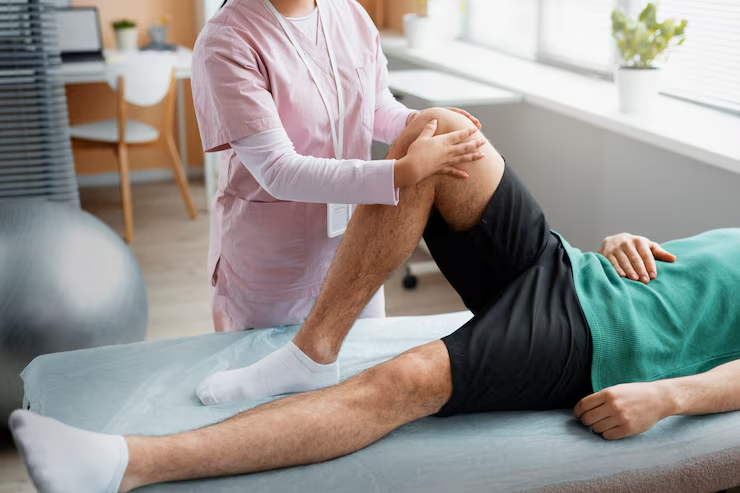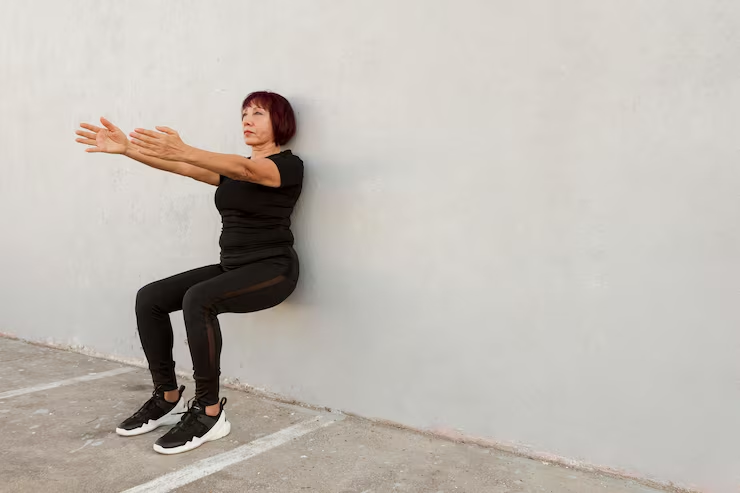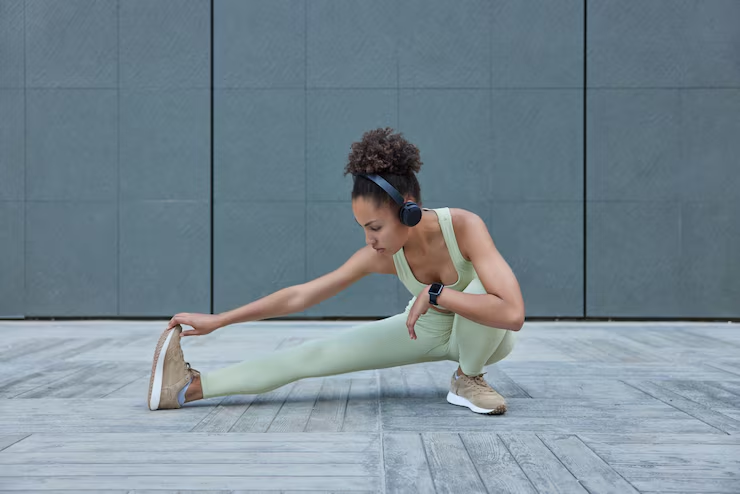Knee health is essential for maintaining mobility, strength, and independence throughout life. The knees are among the most active joints in the body, responsible for supporting your weight during walking, running, climbing, and daily activities. When the knees are strong and flexible, movement feels effortless, but weakness or stiffness can make even simple tasks challenging. This is why incorporating knee health exercises into your routine is so important.
Knee problems are incredibly common, often caused by factors like aging, arthritis, sports injuries, or a sedentary lifestyle. These issues can lead to pain, swelling, and reduced flexibility, limiting your ability to stay active. Strengthening the muscles that support your knees helps relieve pressure on the joints and improves overall stability.
By practicing targeted knee health exercises, you can build muscle strength, enhance flexibility, and prevent injuries. Whether you’re an athlete, senior, or recovering from injury, these exercises are key to long-term joint health.

Why Knee Health Matters
The knee joint is the largest and most complex joint in the human body. It connects the thigh bone (femur) to the shinbone (tibia) and is cushioned by cartilage and supported by ligaments and muscles. When these structures weaken, stress builds up, leading to pain, swelling, and restricted movement.
Healthy knees are essential for:
Walking, running, and climbing stairs
Maintaining balance and stability
Enjoying an active lifestyle without discomfort
Preventing conditions like arthritis and ligament injuries
Neglecting knee health can cause long-term problems, but the right exercises act as preventive medicine.
Top Tips and Exercises for Knee Health
Quadriceps Strengthening (Straight Leg Raises)

One of the most effective knee health exercises is the straight leg raise. This movement directly targets the quadriceps—the large muscles on the front of your thighs that provide essential support to your knees. Strong quadriceps reduce strain on the knee joint, improve stability, and help with everyday activities such as walking, climbing stairs, or standing up from a chair. People with weak quads often experience added pressure on the knee cartilage, leading to discomfort and pain.
To perform this exercise, lie on your back with one leg bent at the knee and the other kept straight. Tighten the thigh muscle of the straight leg and lift it slowly about 12 inches from the ground. Hold the position for 3–5 seconds before lowering it gently. Perform 10–15 repetitions on each leg for best results.
Consistency is key with this exercise. Aim for 2–3 sets daily to notice significant improvement in muscle strength and knee stability. Straight leg raises are especially useful for beginners, seniors, and people recovering from injuries. Adding them to your regular knee health exercises routine ensures that your knees remain strong and supported over time.
Why it works: Strong quadriceps support the knee and reduce stress on the joint.
How to do it:
Lie flat on your back with one leg bent and the other straight.
Tighten the thigh muscle of your straight leg and lift it about 12 inches.
Hold for 3–5 seconds, then slowly lower.
Repeat 10–15 times on each leg.
Tip: Perform 2–3 sets daily for stronger thigh muscles.
Hamstring Curls
Hamstring curls are another valuable addition to knee health exercises, as they focus on the back of the thighs. These muscles are equally important for balancing the strength around your knees. Weak hamstrings can leave the knee joint vulnerable to strain and instability, which increases the risk of injury. Strengthening this area not only improves support but also enhances mobility and athletic performance.
To do hamstring curls, stand upright while holding onto a chair or wall for support. Slowly bend one knee, bringing your heel up toward your buttocks. Hold the position for about 5 seconds before lowering your leg in a controlled manner. Aim for 10–15 repetitions on each leg, ensuring slow and steady movements.
Over time, you can make this exercise more challenging by adding light ankle weights. Including hamstring curls regularly in your knee health exercises routine will ensure balanced muscle development around the knees, making them more resilient to daily stress and physical activities.
Why it works: Strengthens the muscles at the back of the thighs, balancing knee support.
How to do it:
Stand and hold onto a chair or wall for balance.
Bend one knee, bringing your heel toward your buttocks.
Hold for 5 seconds, then lower slowly.
Do 10–15 repetitions per leg.
Tip: Add light ankle weights for more resistance as you progress.
Calf Raises
Calf raises are a simple yet powerful part of knee health exercises. The calves play a key role in supporting the ankle and lower leg, which in turn reduces unnecessary strain on the knee joint. Strong calves help improve balance, stability, and shock absorption during walking, running, and climbing stairs. This makes them an essential component of a comprehensive knee-care routine.
To perform calf raises, stand upright with your feet hip-width apart. Slowly lift your heels so you’re standing on your toes, engaging the calf muscles. Hold for 3 seconds at the top before lowering back down. Repeat this movement 15–20 times. Beginners can use a wall or chair for balance, while advanced individuals can perform calf raises on a step for a greater range of motion.
Practicing calf raises regularly will help strengthen your lower legs and provide additional support to the knees. When included in your knee health exercises, they contribute to improved mobility, reduced pain, and stronger lower-body endurance.
Why it works: Strong calves stabilize the lower leg and ease knee strain.
How to do it:
Stand upright with feet hip-width apart.
Slowly lift your heels until you’re standing on your toes.
Hold for 3 seconds, then lower back down.
Perform 15–20 reps.
Tip: Do this exercise near a wall or chair if you need support.
Step-Ups
Step-ups are one of the most functional knee health exercises since they mimic everyday movements like climbing stairs. They engage multiple muscle groups including the quadriceps, hamstrings, glutes, and calves, making them an excellent all-around workout for knee strength and stability. Regular practice of step-ups enhances balance, coordination, and joint health.
To perform this exercise, stand in front of a low step or sturdy platform. Step up with one foot, followed by the other, then step back down in the same sequence. Do 10–12 repetitions per leg, keeping your movements controlled and steady. Start with a low platform and increase the height as your strength and confidence improve.
Step-ups are effective for building both strength and endurance. Including them in your knee health exercises routine improves functional strength for daily life, making simple tasks easier and reducing knee strain during physical activity.
Why it works: Builds knee strength, balance, and coordination.
How to do it:
Stand in front of a low step or platform.
Step up with one foot, then bring the other foot up.
Step down the same way.
Repeat 10–12 times per leg.
Tip: Start with a low step and gradually increase height as strength improves.
Wall Sits

Wall sits are an excellent isometric exercise that builds strength without repetitive movement, making them ideal for people with knee pain. As part of your knee health exercises, wall sits engage the quadriceps, hamstrings, and glutes simultaneously, improving joint stability and endurance. This static hold also trains your muscles to provide consistent support to your knees.
To perform wall sits, stand with your back against a wall and slide down until your knees form a 90-degree angle. Keep your thighs parallel to the floor and hold the position for 15–30 seconds. Repeat 3–5 times, gradually increasing your hold duration as your strength improves. Be sure to keep your knees aligned with your ankles to avoid excess pressure.
Wall sits not only strengthen the muscles supporting your knees but also build mental endurance. Adding them to your knee health exercises routine helps prevent injury, relieves pressure from the joint, and promotes stronger, more resilient knees.
Why it works: Engages quads, glutes, and hamstrings for overall knee stability.
How to do it:
Stand with your back against a wall.
Slide down until your knees are bent at a 90-degree angle.
Hold this position for 15–30 seconds.
Repeat 3–5 times.
Tip: Keep your knees aligned with your ankles, not over your toes.
Glute Bridges
Glute bridges are often overlooked in knee health exercises, but they play a crucial role in reducing stress on the knees. Strong glutes stabilize the hips, which prevents improper movement patterns that can strain the knees. By strengthening the glutes, you create a solid foundation for lower-body alignment and knee protection.
To perform a glute bridge, lie on your back with your knees bent and feet flat on the ground. Tighten your core and lift your hips upward until your shoulders, hips, and knees form a straight line. Hold the position for 5 seconds, then lower back down slowly. Repeat the exercise 10–15 times.
Squeezing your glutes at the top of the movement maximizes results. Regularly performing glute bridges as part of your knee health exercises not only supports the knees but also improves posture, core strength, and overall lower-body stability.
Why it works: Strong glutes reduce knee stress by improving hip stability.
How to do it:
Lie on your back with knees bent and feet flat.
Tighten your core and lift hips upward until shoulders, hips, and knees form a line.
Hold for 5 seconds, then lower slowly.
Repeat 10–15 times.
Tip: Squeeze your glutes at the top for maximum benefit.
Low-Impact Cardio (Cycling or Swimming)
Low-impact cardio activities such as cycling and swimming are excellent for maintaining knee health without adding excessive strain. These exercises improve blood circulation, enhance joint lubrication, and promote mobility. For people with arthritis or chronic knee pain, low-impact cardio is a safe and effective way to stay active.
Cycling on a stationary bike for 15–20 minutes helps strengthen leg muscles and keeps the joints moving smoothly. Swimming or water aerobics reduces the load on your knees while still providing a full-body workout. These activities also build endurance, allowing you to perform daily tasks more easily.
Incorporating low-impact cardio into your weekly knee health exercises routine supports long-term joint health. Aim for 3–4 sessions per week to improve stamina, strengthen muscles, and reduce stiffness—all while protecting your knees from high-impact stress.
Why it works: Boosts knee mobility and blood flow without high impact.
How to do it:
Ride a stationary bike for 15–20 minutes.
Swim laps or do water aerobics for joint-friendly exercise.
Tip: Include cardio 3–4 times a week for endurance and joint health.
Stretching and Flexibility Exercises

Stretching is a vital part of knee health exercises because it prevents stiffness and improves range of motion. Flexible muscles reduce unnecessary pulling on the knee joint, which can otherwise cause discomfort or injury. Daily stretching also promotes relaxation and better recovery after workouts.
Some of the most effective stretches include hamstring stretches, quad stretches, and calf stretches. Hold each stretch for 20–30 seconds without bouncing, and repeat them 2–3 times per leg. Performing these stretches after workouts or during daily routines ensures your muscles remain loose and joints function smoothly.
By incorporating stretching into your knee health exercises, you create a balanced program that not only strengthens but also lengthens the muscles around the knees. This combination helps you move more freely, reduces pain, and keeps your knees healthy and resilient in the long term.
Why it works: Keeps muscles around the knee loose, reducing stiffness.
How to do it:
Perform hamstring stretches, quad stretches, and calf stretches daily.
Hold each stretch for 20–30 seconds.
Tip: Never bounce during stretches—move slowly and gently.
Lifestyle Tips to Support Knee Health
In addition to exercises, daily habits make a difference:
Maintain a healthy weight: Every extra pound puts added stress on your knees.
Wear proper shoes: Supportive footwear reduces joint strain.
Stay hydrated: Cartilage needs hydration to stay healthy.
Add joint-friendly foods: Omega-3s, calcium, and vitamin D support cartilage and bone health.
Take breaks from sitting: Move every 30–40 minutes to avoid stiffness.
Who Should Do Knee Health Exercises?
Athletes wanting injury prevention
Seniors aiming to stay mobile and independent
People with arthritis to reduce pain and stiffness
Post-injury recovery patients with doctor approval
Anyone looking to protect their knees for the long term
Benefits of Knee Health Exercises
Regular knee health exercises provide numerous benefits:
Strengthens muscles around the knee, reducing pressure on the joint.
Improves flexibility and range of motion for smoother movement.
Supports weight management, easing strain on the knees.
Reduces injury risk by stabilizing ligaments and tendons.
Promotes blood circulation for faster healing and recovery.
Relieves pain and stiffness, especially in arthritis patients.
Enhances overall mobility, balance, and posture.
Safety Tips Before Starting Knee Health Exercises
Before you jump into workouts, keep these tips in mind:
Warm up first: Gentle stretching or a 5-minute walk reduces injury risk.
Start slow: Don’t push too hard if you’re new to exercise.
Use proper form: Correct posture ensures safety and effectiveness.
Avoid high-impact moves: Activities like jumping may worsen pain.
Consult a doctor or physiotherapist if you have severe knee conditions.
Listen to your body: Stop if you feel sharp or worsening pain.
Conclusion

Knee health is not just about avoiding pain—it’s about ensuring long-term mobility, strength, and independence. With the right knee health exercises, you can strengthen supporting muscles, improve flexibility, and protect your joints from wear and tear.
By incorporating the top 8 knee exercises—from leg raises and hamstring curls to step-ups, wall sits, and low-impact cardio—you can enjoy stronger, healthier knees at any age. Pair these with smart lifestyle habits like weight management, hydration, and proper nutrition, and your knees will carry you smoothly through life.
Remember: Start slow, stay consistent, and listen to your body. Your knees deserve the best care, and with these exercises, you’ll be on the path to lasting joint health.
FAQs
Q1. What are the best knee health exercises for beginners ?
For beginners, the safest and most effective knee health exercises include straight leg raises, hamstring curls, calf raises, and wall sits. These movements are low-impact, easy to perform at home, and help strengthen the muscles around the knees without causing strain.
Q2. Can knee health exercises help with arthritis pain ?
Yes, knee health exercises can greatly reduce arthritis-related pain and stiffness. Strengthening the muscles around the knees helps take pressure off the joints, while stretching improves flexibility. Low-impact cardio like cycling or swimming is especially beneficial for people with arthritis.
Q3. How often should I do knee health exercises ?
It’s generally recommended to perform knee health exercises 3–5 times per week. Strengthening exercises can be done on alternate days, while stretching and low-impact cardio can be practiced daily. Always listen to your body and rest if you feel pain.
Q4. Are knee health exercises safe for seniors ?
Absolutely. Knee health exercises are very beneficial for seniors, as they help maintain mobility, balance, and independence. Gentle exercises like step-ups, glute bridges, and flexibility stretches are safe options. Seniors should start slow and consult a doctor before beginning a new routine.
Q5. Do I need equipment for knee health exercises ?
Most knee health exercises require little to no equipment. A sturdy chair, yoga mat, or step platform may be useful, but bodyweight exercises are often enough. As you progress, you can add light ankle weights or resistance bands for more challenge.

